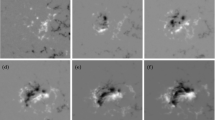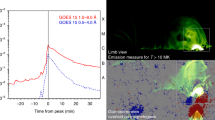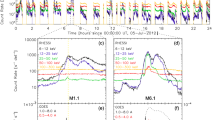Abstract
All three components of the current density are required to compute the heating rate due to free magnetic energy dissipation. Here we present a first test of a new model developed to determine if the times of increases in the resistive heating rate in active region (AR) photospheres are correlated with the subsequent occurrence of M and X flares in the corona. A data driven, 3D, non-force-free magnetohydrodynamic model restricted to the near-photospheric region is used to compute time series of the complete current density and the resistive heating rate per unit volume [Q(t)] in each pixel in neutral line regions (NLRs) of 14 ARs. The model is driven by time series of the magnetic field B measured by the Helioseismic & Magnetic Imager on the Solar Dynamics Observatory (SDO) satellite. Spurious Doppler periods due to SDO orbital motion are filtered out of the time series for B in every AR pixel. For each AR, the cumulative distribution function (CDF) of the values of the NLR area integral Qi(t) of Q(t) is found to be a scale invariant power law distribution essentially identical to the observed CDF for the total energy released in coronal flares. This suggests that coronal flares and the photospheric Qi are correlated, and powered by the same process. The model predicts spikes in Qi with values orders of magnitude above background values. These spikes are driven by spikes in the non-force free component of the current density. The times of these spikes are plausibly correlated with times of subsequent M or X flares a few hours to a few days later. The spikes occur on granulation scales, and may be signatures of heating in horizontal current sheets. It is also found that the times of relatively large values of the rate of change of the NLR unsigned magnetic flux are also plausibly correlated with the times of subsequent M and X flares, and spikes in Qi.
Similar content being viewed by others
References
M. J. Hagyard, D. Jr Smith, D. Teuber, and E. A. West, A quantitative study relating observed shear in photo-spheric magnetic fields to repeated flaring, Sol. Phys. 91(1), 115 (1984)
C. J. Schrijver, Driving major solar flares and eruptions: A review, Adv. Space Res. 43(5), 739 (2009)
L. Fletcher, B. R. Dennis, H. S. Hudson, S. Krucker, K. Phillips, A. Veronig, M. Battaglia, L. Bone, A. Caspi, Q. Chen, P. Gallagher, P. T. Grigis, H. Ji, W. Liu, R. O. Milligan, and M. Temmer, An observational overview of solar flares, Space Sci. Rev. 159(1–4), 19 (2011)
H. S. Hudson, Global properties of solar flares, Space Sci. Rev. 158(1), 5 (2011)
M. K. Georgoulis, V. S. Titov, and Z. Mikić, Non-neutralized electric current patterns in solar active regions: Origin of the shear-generating Lorentz force, Astrophys. J. 761(1), 61 (2012)
H. Wang and C. Liu, Structure and evolution of magnetic fields associated with solar eruptions, Res. Astron. Astrophys. 15(2), 145 (2015)
N. Gyenge, N. Ballai, and T. Baranyi, Statistical study of spatio-temporal distribution of precursor solar flares associated with major flares, Mon. Not. R. Astron. Soc. 459(4), 3532 (2016)
L. G. Balázs, N. Gyenge, M. B. Korsós, T. Baranyi, E. Forgács-Dajka, and I. Ballai, Statistical relationship between the succeeding solar flares detected by the RHESSI satellite, Mon. Not. R. Astron. Soc. 441(2), 1157 (2014)
D. L. Chesny, H. M. Oluseyi, and N. B. Orange, Helium-abundance and other composition effects on the properties of stellar surface convection in solar-like main-sequence stars, Astrophys. J. 778(2), 117 (2013)
T. Török, J. E. Leake, T. S. Titov, V. Archontis, Z. Mikić, M. G. Linton, K. Dalmasse, G. Aulanier, and B. Kliem, Distribution of electric currents in solar active regions, Astrophys. J. 782(1), L10 (2014)
P. H. Scherrer, R. S. Bogart, R. I. Bush, J. T. Hoeksema, A. G. Kosovichev, J. Schou, W. Rosenberg, L. Springer, T. D. Tarbell, A. Title, C. J. Wolfson, and I. Zayer, The solar oscillations investigation — Michelson Doppler imager, Sol. Phys. 162(1–2), 129 (1995)
R. C. Canfield, 1993, NASA-CR-194729, Solar Imaging Vector Magnetograph, Final Technical Report for NASA Grant NAGW-1454, 1 Aug. 1988–31 Jul. 1993 (Univ. of Hawaii)
D. A. Falconer, R. L. Moore, and G. A. Gary, Magnetic causes of solar coronal mass ejections: Dominance of the free magnetic energy over the magnetic twist alone, Astrophys. J. 644(2), 1258 (2006)
D. A. Falconer, R. L. Moore, and G. A. Gary, Magnetogram measures of total nonpotentiality for prediction of solar coronal mass ejections from active regions of any degree of magnetic complexity, Astrophys. J. 689(2), 1433 (2008)
D. Falconer, A. F. Barghouty, I. Khazanov, and M. Moore, A tool for empirical forecasting of major flares, coronal mass ejections, and solar particle events from a proxy of active-region free magnetic energy, Space Weather 9(4), S04003 (2011)
D. A. Falconer, R. L. Moore, A. F. Barghouty, and I. Khazanov, Prior flaring as a complement to free magnetic energy for forecasting solar eruptions, Astrophys. J. 757(1), 32 (2012)
D. A. Falconer, R. L. Moore, A. F. Barghouty, and I. Khazanov, MAG4 versus alternative techniques for forecasting active region flare productivity, Space Weather 12(5), 306 (2014)
C. J. Schrijver, A characteristic magnetic field pattern associated with all major solar flares and its use in flare forecasting, Astrophys. J. 655(2), L117 (2007)
M. B. Korsós, T. Baranyi, and A. Ludmány, Pre-flare dynamics of sunspot groups, Astrophys. J. 789(2), 107 (2014)
M. B. Korsós, A. Ludmány, R. Erdélyi, and T. Baranyi, On flare predictability based on sunspot group evolution, Astrophys. J. 802(2), L21 (2015a)
M. B. Korsós, N. Gyenge, T. Baranyi, and A. Ludmány, Dynamic precursors of flares in active region NOAA 10486, J. Astrophys. Astron. 36(1), 111 (2015b)
M. B. Korsós and R. Erdélyi, On the state of a solar active region before flares and CMEs, Astrophys. J. 823(2), 153 (2016)
M. K. Georgoulis and D. M. Rust, Quantitative forecasting of major solar flares, Astrophys. J. 661(1), L109 (2007)
M. K. Georgoulis, 2011, in Physics of Sun and Star Spots, Proceedings IAU Symposium No. 273, 2010, pg. 495 (International Astronomical Union 2011)
K. D. Leka and G. Barnes, Photospheric magnetic field properties of flaring versus flare-quiet active regions (I): Data, general approach, and sample results, Astrophys. J. 595(2), 1277 (2003a)
K. D. Leka and G. Barnes, Photospheric magnetic field properties of flaring versus flare-quiet active regions (II): Discriminant analysis, Astrophys. J. 595(2), 1296 (2003b)
K. D. Leka and G. Barnes, Photospheric magnetic field properties of flaring versus flare-quiet active regions (IV): A statistically significant sample, Astrophys. J. 656(2), 1173 (2007)
G. Barnes, and K. D. Leka, Photospheric magnetic field properties of flaring versus flare-quiet active regions (III): Magnetic charge topology models, Astrophys. J. 646(2), 1303 (2006)
Wang, J., Shi, Z., Wang, H. & Lü, Y. 1996, 456, 861
Y. Lü, J. Wang, and H. Wang, Shear angle of magnetic fields, Sol. Phys. 148(1), 119 (1993)
G. Barnes, K. D. Leka, C. J. Schrijver, T. Colak, R. Qahwaji, O. W. Ashamari, Y. Yuan, J. Zhang, R. T. J. McAteer, D. S. Bloomfield, P. A. Higgins, P. T. Gallagher, D. A. Falconer, M. K. Georgoulis, M. S. Wheatland, C. Balch, T. Dunn, and E. L. Wagner, A comparison of flare forecasting methods (i): Results from the “all-clear” workshop, Astrophys. J. 829(2), 89 (2016)
P. H. Scherrer, J. Schou, R. I. Bush, A. G. Kosovichev, R. S. Bogart, J. T. Hoeksema, Y. Liu, T. L. Jr Duvall, J. Zhao, A. M. Title, C. J. Schrijver, T. D. Tarbell, and S. Tomczyk, The helioseismic and magnetic imager (HMI) investigation for the solar dynamics observatory (SDO), Sol. Phys. 275(1), 207 (2012)
M. G. Bobra, X. Sun, J. T. Hoeksema, M. Turmon, Y. Liu, K. Hayashi, G. Barnes, and K. D. Leka, The helioseismic and magnetic imager (HMI) vector magnetic field pipeline: SHARPs — Space-weather HMI active region patches, Sol. Phys. 289(9), 3549 (2014)
J. T. Hoeksema, Y. Liu, K. Hayashi, X. Sun, J. Schou, S. Couvidat, A. Norton, M. Bobra, R. Centeno, K. D. Leka, G. Barnes, and M. Turmon, The helioseismic and magnetic imager (HMI) vector magnetic field pipeline: Overview and performance, Sol. Phys. 289(9), 3483 (2014)
Å. Nordlund, R. F. Stein, and M. Asplund, Solar Surface Convection, Living Rev. Sol. Phys. 6, 2 (2009)
B. W. Lites, K. D. Leka, A. Skumanich, V. Martínez Pillet, and T. Shimizu, Small-scale horizontal magnetic fields in the solar photosphere, Astrophys. J. 460, 1019 (1996)
B. W. Lites, A. Skumanich, and V. Martínez Pillet, Astron. Astrophys. 333, 1053 (1998)
B. W. Lites, M. Kubo, H. Socas-Navarro, T. Berger, Z. Frank, R. Shine, T. Tarbell, A. Title, K. Ichimoto, Y. Katsukawa, S. Tsuneta, Y. Suematsu, T. Shimizu, and S. Nagata, The horizontal magnetic flux of the quiet-Sun internetwork as observed with the hinode spectro-polarimeter, Astrophys. J. 672(2), 1237 (2008)
D. Orozco Suárez, L. R. Bellot Rubio, J. C. del Toro Iniesta, S. Tsuneta, B. W. Lites, K. Ichimoto, Y. Katsukawa, S. Nagata, T. Shimizu, R. A. Shine, Y. Suematsu, T. D. Tarbell, and A. M. Title, Quiet-Sun internetwork magnetic fields from the inversion of Hinode measurements, Astrophys. J. 670(1), L61 (2007)
B. W. Lites, The topology and behavior of magnetic fields emerging at the solar photosphere, Space Sci. Rev. 144(1–4), 197 (2009)
S14 2014, Final Report for NASA Phase 1 SBIR Contract NNX14CG30P: “A New Class of Flare Prediction Algorithms: A Synthesis of Data, Pattern Recognition Algorithms, and First Principles Magnetohydrodynamics”, (Accepted by the NASA Technology Transfer System on December 22, 2014, Case No. GSC-17381-1). The report is available at goo.gl/jQh0YX. Note: The PI name on the report is not correct. The PI is Chiman Kwan. The report was written by the PI and M. L. Goodman, M. C. Cheung, and M. L. DeRosa, A method for data-driven simulations of evolving solar active regions, Astrophys. J. 757(2), 147 (2012)
X. Sun, On the coordinate system of space-weather HMI active region patches (SHARPs): A technical note, arxiv: 1309.2392 (2013)
M. G. Bobra, 2014, private communication
J. D. Jackson, Classical Electrodynamics, 3rd Ed., John Wiley & Sons, 1999
M. L. Goodman, On the efficiency of plasma heating by Pedersen current dissipation from the photosphere to the lower corona, Astron. Astrophys. 416(3), 1159 (2004)
V. Smirnova, A. Richokainen, A. Solovev, J. Kallunki, A. Zhiltsov, and V. Ryzhov, Long quasi-periodic oscillations of sunspots and nearby magnetic structures, Astron. Astrophys. 552, A23 (2013a)
V. Smirnova, V. I. Efremov, L. D. Parfinenko, A. Riehokainen, and A. A. Solov’ev, Artifacts of SDO/HMI data and long-period oscillations of sunspots, Astron. Astrophys. 554, A121 (2013b)
P. V. Strekalova, Y. A. Nagovitsyn, A. Riehokainen, and V. V. Smirnova, Long-period variations in the magnetic field of small-scale solar structures., Geomagn. Aeron. 56(8), 1052 (2016)
S. Couvidat, J. Schou, J. T. Hoeksema, R. S. Bogart, R. I. Bush, T. L. Jr Duvall, Y. Liu, A. A. Norton, and P. H. Scherrer, Observables processing for the helioseismic and magnetic imager instrument on the solar dynamics observatory, Sol. Phys. 291(7), 1887 (2016)
Y. Liu, J. T. Hoeksema, P. H. Scherrer, J. Schou, S. Couvidat, R. I. Bush, K. Jr Duvall, X. Hayashi, X. Sun, and X. Zhao, Comparison of line-of-sight magnetograms taken by the solar dynamics observatory/helioseismic and magnetic imager and solar and heliospheric observatory/Michelson Doppler imager, Sol. Phys. 279(1), 295 (2012)
A. G. de Wijn, J. O. Stenflo, S. K. Solanki, and S. Tsuneta, Small-scale solar magnetic fields, Space Sci. Rev. 144(1–4), 275 (2009)
H. Peter, H. Tian, W. Curdt, D. Schmit, D. Innes, B. De Pontieu, J. Lemen, A. Title, P. Boerner, N. Hurlburt, T. D. Tarbell, J. P. Wuelser, J. Martinez-Sykora, L. Kleint, L. Golub, S. McKillop, K. K. Reeves, S. Saar, P. Testa, C. Kankelborg, S. Jaeggli, M. Carlsson, and V. Hansteen, Hot explosions in the cool atmosphere of the Sun, Science 346(6207), 1255726 (2014)
P. G. Judge, UV spectra, bombs, and the solar atmosphere, Astrophys. J. 808(2), 116 (2015)
G. R. Gupta and D. Tripathi, IRIS and SDO observations of recurrent explosive events, Astrophys. J. 809(1), 82 (2015)
G. J. M. Vissers, L. H. M. Rouppe van der Voort, R. J. Rutten, M. Carlsson, and B. De Pontieu, Ellerman bombs at high resolution (iii): Simultaneous observations with IRIS and SST, Astrophys. J. 812(1), 11 (2015)
Y. H. Kim, V. Yurchyshyn, S. C. Bong, I. H. Cho, K. S. Cho, J. Lee, E. K. Lim, Y. D. Park, H. Yang, K. Ahn, P. R. Goode, and B. H. Jang, Simultaneous observation of a hot explosion by NST and IRIS, Astrophys. J. 810(1), 38 (2015)
H. Tian, Z. Xu, J. He, and C. Madsen, Are IRIS bombs connected to Ellerman bombs? Astrophys. J. 824(2), 96 (2016)
R. J. Rutten, H a features with hot onsets, Astron. Astrophys. 590, A124 (2016)
R. J. Rutten, Solar H-alpha features with hot onsets, Astron. Astrophys. 598, A89 (2017)
L. P. Chitta, H. Peter, P. R. Young, and Y. M. Huant, Compact solar UV burst triggered in a magnetic field with a fan-spine topology, Astron. Astrophys. 605, A49 (2017)
H. Tian, V. Yurchyshyn, H. Peter, S. K. Solanki, P. R. Young, L. Ni, W. Cao, K. Ji, Y. Zhu, J. Zhang, T. Samanta, Y. Song, J. He, L. Wang, and Y. Chen, Frequently occurring reconnection jets from Sunspot light bridges, Astrophys. J. 854(2), 92 (2018a)
H. Tian, X. Zhu, H. Peter, J. Zhao, T. Samanta, and Y. Chen, Magnetic reconnection at the earliest stage of solar flux emergence, Astrophys. J. 854(2), 174 (2018b)
N. W. Watkins, G. Pruessner, S. C. Chapman, N. B. Crosby, and H. J. Jensen, 25 years of self-organized criticality: Concepts and controversies, Space Sci. Rev. 198(1), 3 (2016)
P. Bak, C. Tang, and K. Wiesenfeld, Self-organized criticality: An explanation of the 1/f noise, Phys. Rev. Lett. 59(4), 381 (1987)
C. Tang, K. Wiesenfeld, P. Bak, S. Coppersmith, and P. Littlewood, Phase organization, Phys. Rev. Lett. 58(12), 1161 (1987)
L. Kadanoff, in: Springer Proceedings in Physics, V. 57, Evolutionary Trends in the Physical Sciences, Eds. M. Suzuki and R. Kubo, Springer-Verlag Berlin Heidelberg, 1991
P. G. Drazin, Nonlinear Systems, Cambridge University Press, Cambridge Texts in Applied Mathematics, 1992
P. Bak, How Nature Works, Springer Science + Business Media New York, 1996
M. E. J. Newman, Power laws, Pareto distributions and Zipf’s law, Contemp. Phys. 46(5), 323 (2005)
D. W. Datlowe, M. J. Elcan, and H. S. Hudson, OSO-7 observations of solar X-rays in the energy range 10–100 keV, Sol. Phys. 39(1), 155 (1974)
M. S. Wheatland, Flare frequency-size distributions for individual active regions, Astrophys. J. 532(2), 1209 (2000)
M. S. Wheatland, Evidence for departure from a power-law flare size distribution for a small solar active region, Astrophys. J. 710(2), 1324 (2010)
H. S. Hudson, Solar flares, microflares, nanoflares, and coronal heating, Sol. Phys. 133(2), 357 (1991)
N. B. Crosby, M. J. Aschwanden, and B. R. Dennis, Frequency distributions and correlations of solar X-ray flare parameters, Sol. Phys. 143(2), 275 (1993)
T. Shimizu, Publ. Astron. Soc. Jpn. 47, 251 (1995)
M. J. Aschwanden, and C. E. Parnell, Nanoflare statistics from first principles: Fractal geometry and temperature synthesis, Astrophys. J. 572(2), 1048 (2002)
M. J. Aschwanden, A statistical fractal-diffusive avalanche model of a slowly-driven self-organized criticality system, Astron. Astrophys. 539, A2 (2012)
M. J. Aschwnaden, in: Self Organized Criticality Systems, Ed. M. J. Aschwanden, Open Academic Press: Berlin, Warsaw, 2013, http://www.openacademicpress.de/
M. J. Aschwanden, N. B. Crosby, M. Dimitropoulou, M. K. Georgoulis, S. Hergarten, J. McAteer, A. V. Milovanov, S. Mineshige, L. Morales, N. Nishizuka, G. Pruessner, R. Sanchez, A. S. Sharma, A. Strugarek, and V. Uritsky, 25 years of self-organized criticality: Solar and astrophysics, Space Sci. Rev. 198(1–4), 47 (2016)
E. T. Lu and R. J. Hamilton, Avalanches and the distribution of solar flares, Astrophys. J. 380, L89 (1991)
E. T. Lu, R. J. Hamilton, J. M. McTiernan, and K. R. Bromund, Solar flares and avalanches in driven dissipative systems, Astrophys. J. 412, 841 (1993)
P. Charbonneau, S. W. McIntosh, H. Liu, and T. Bogdan, Avalanche models for solar flares, Sol. Phys. 203(2), 321 (2001)
S. W. McIntosh, P. Charbonneau, T. J. Bogdan, H. Liu, and J. P. Norman, Geometrical properties of avalanches in self-organized critical models of solar flares, Phys. Rev. E 65(4), 046125 (2002)
L. Vlahos and M. K. Georgoulis, On the self-similarity of unstable magnetic discontinuities in solar active regions, Astrophys. J. 603(1), L61 (2004)
M. S. Wheatland and I. J. D. Craig, Toward a reconnection model for solar flare statistics, Astrophys. J. 595(1), 458 (2003)
V. M. Uritsky, J. M. Davila, L. Ofman, and A. J. Coyner, Stochastic coupling of solar photosphere and corona, Astrophys. J. 769(1), 62 (2013)
V. M. Uritsky and J. M. Davila, Spatiotemporal organization of energy release events in the quiet solar corona, Astrophys. J. 795(1), 15 (2014)
R. A. Howard, J. D. Moses, A. Vourlidas, J. S. Newmark, D. G. Socker, et al., Sun earth connection coronal and heliospheric investigation (SECCHI), Space Sci. Rev. 136(1–4), 67 (2008)
Acknowledgements
This work was partially supported by a NASA Phase I SBIR award (Contract No. NNX14CG30P) to Applied Research LLC. This work made use of NASA’s Astrophysics Data System (ADS). The authors are grateful to the HMI team, especially Phil Scherrer, Todd Hoeksema, Yang Liu, Monica Bobra, and Rebecca Centeno for much advice about HMI data issues. MLG thanks the Jacobs Space Exploration Group and the NASA MSFC Natural Environments Branch-EV44 for partial support of this work. The authors are also grateful to the several referees whose comments significantly improved the paper.
Author information
Authors and Affiliations
Corresponding author
Rights and permissions
About this article
Cite this article
Goodman, M.L., Kwan, C., Ayhan, B. et al. A new approach to solar flare prediction. Front. Phys. 15, 34601 (2020). https://doi.org/10.1007/s11467-020-0956-6
Received:
Accepted:
Published:
DOI: https://doi.org/10.1007/s11467-020-0956-6




